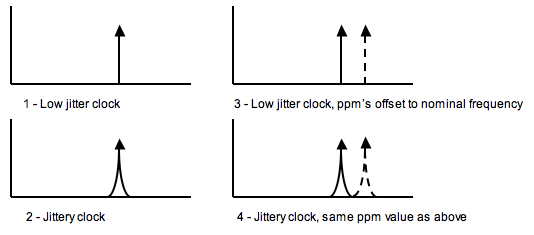About the XO and VCXO
This page describes the history and background of TentLabs XO’s and VCXO’s. Although they look like off the shelf units, their internals are not.Canned modules
In our belief, the heart of every oscillator should be well screened. Low jitter oscillators require high Q networks, like crystals or LC combinations. As a result of the high Q requirements, the impedances of the networks involved are very high. Without screening, external fields affect the oscillating function, inducing jitter.Integrated oscillators
Most integrated oscillators are based upon standard inverters. These however do not perform very well when it comes to jitter. Designing proper clocks requires skills of analogue, RF electronics and last but not least (expensive) measurement equipment. When one wants an integrated oscillator, an integrated circuit that drives the crystal is unavoidable.In search for the best clocks, I evaluated over 30 different circuits (thanks to all the companies that provided samples for free).
The evaluation consisted of 3 elements:
1. Measurement (using Wavecrest 3000 and HP53310A)
2. Listening test (using TEAC VDRS10)
3. Backwards engineering
Ultimately 2 out of these 30 units performed well in the listening tests. These also showed lowest measured jitter, though not yet low enough. After studying the concepts, I found room for improvement. These improvements consisted layout, circuit, supply decoupling and physical construction (crystal).
Tentlabs XO
The resulting oscillators are now manufactured exclusively for Tentlabs, and made available in various frequencies, supporting most applications.The VCXO, used in many PLL circuits, and for example in XO DAC, is a direct derivative of the XO, hence shows similar performance.
Why ppm values are useless when specifying jitter
Below picture shows frequency - amplitude spectra of clocks:
The clean clock (1) is just a single frequency in the spectrum, the jittery clock (2) has skirts around that single frequency. Now two other clocks are shown right, a low jitter clock (3), and a jittery clock (4). Both 3 and 4 having the same ppm value but clearly differ in jitter performance.........
For the same reason it makes absolutely no sense to buy temperature compensated or stabilized oscillators let alone rubidium clocks: These are optimized for long-term stability - not what you are looking for when purchasing a proper clock for audio conversion.
Bottom line
Forget ppm values as quality parameter. even worse, avoid clock suppliers that still use this parameter to promote their clocks as they clearly show they don't know their subject......See the XO page or VCXO page for more info regarding availability.